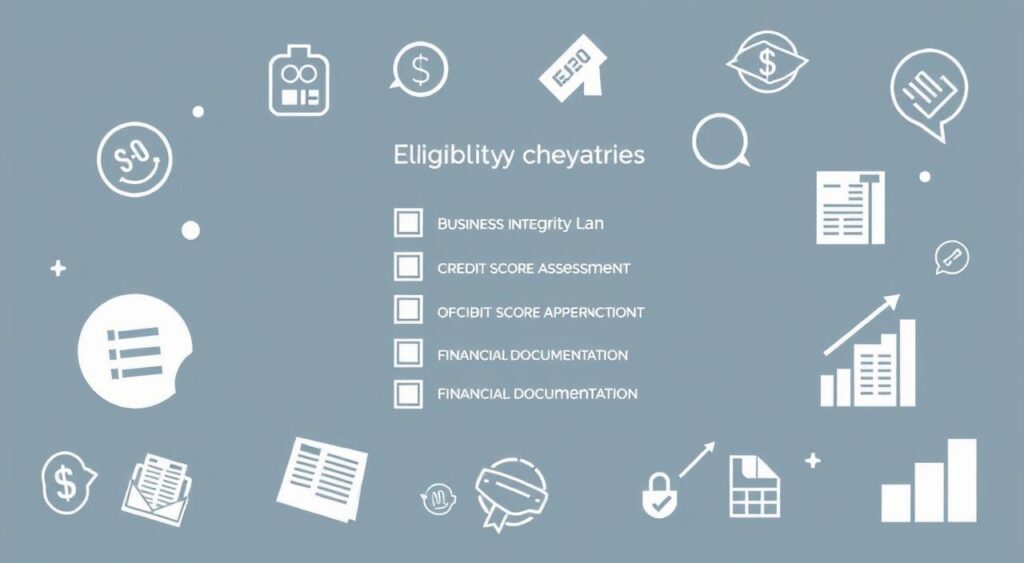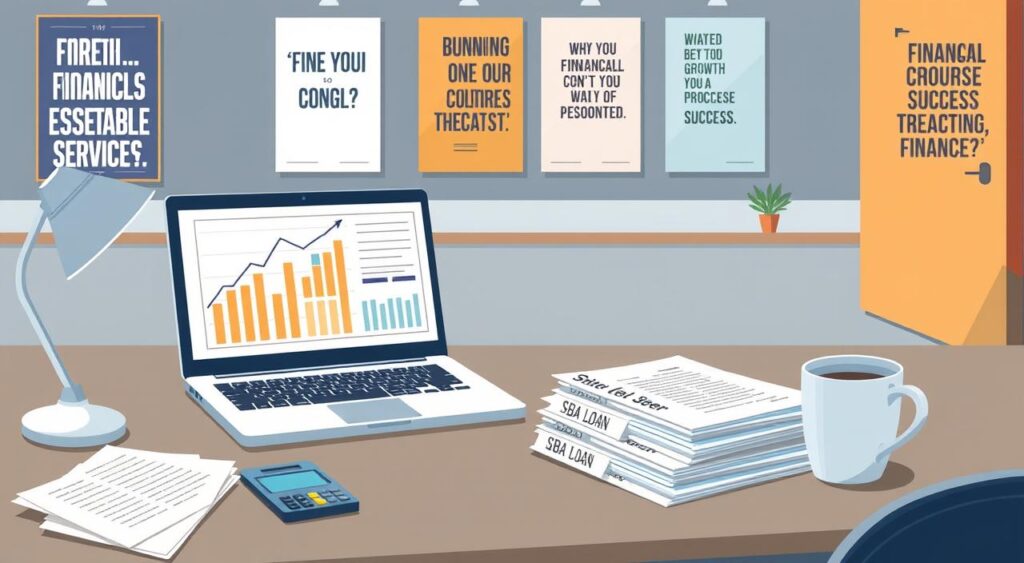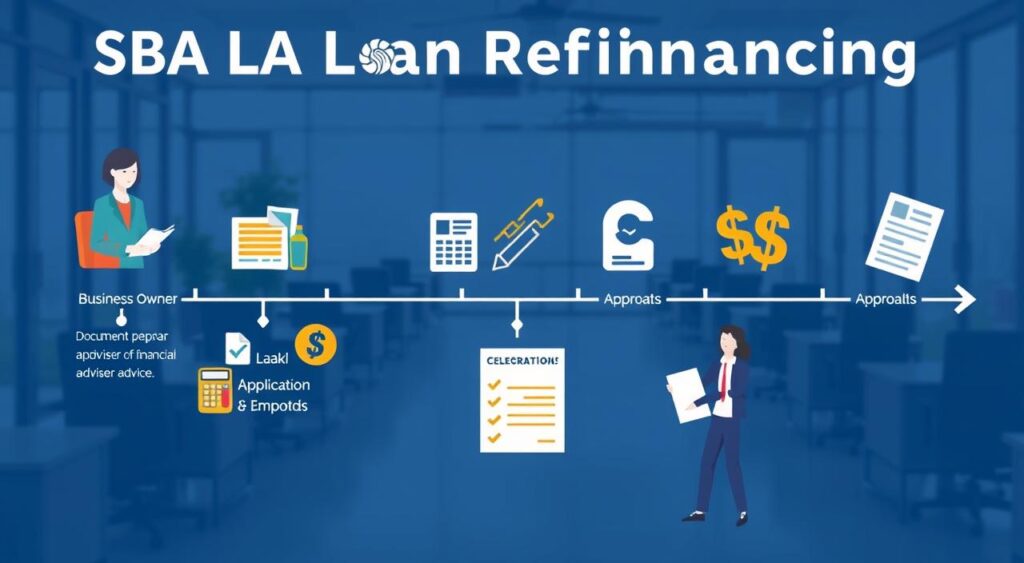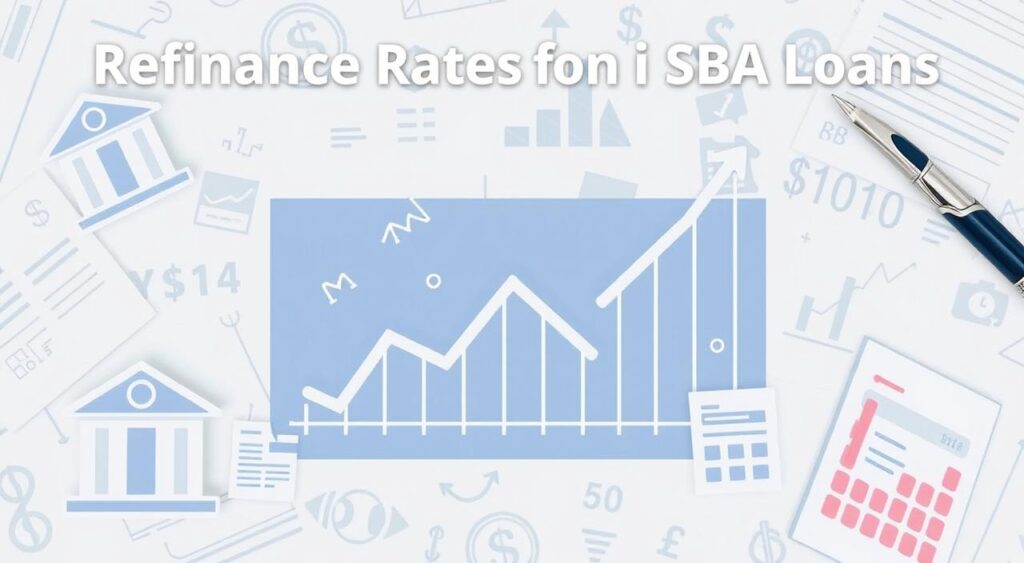Did you know over $28 billion in Small Business Administration (SBA) loans were refinanced in 2022? This shows how many small business owners want to cut their borrowing costs. They aim to improve their financial health. Refinancing your SBA loan might be what you need to lower your interest rate, extend your loan, or get more working capital.
In this guide, we’ll cover everything about SBA loan refinancing. We’ll talk about the process, who can refinance, and how to apply. By the end, you’ll know how to manage your SBA loan and save money for your business.
Key Takeaways
- Refinancing an SBA loan can help small business owners lower interest rates, extend loan terms, and access additional capital.
- Eligibility for SBA loan refinancing is based on factors like credit score, financial statements, and collateral.
- The refinancing process involves gathering required documents, reviewing credit and financials, and navigating the application with a lender.
- Comparing interest rates, fees, and lender offerings is crucial to finding the best refinancing solution for your business.
- Timing your SBA loan refinancing can maximize the potential benefits, such as taking advantage of market conditions or aligning with your business needs.
Understanding SBA Loan Refinancing
Refinancing an SBA loan can help small business owners manage their finances better. It involves swapping an old SBA loan for a new one, often with better terms. This can lead to lower monthly payments and easier management of multiple loans.
What is SBA Loan Refinancing?
SBA loan refinancing means swapping an old SBA loan for a new one. Reasons include getting a lower interest rate, extending repayment, or combining loans. The SBA has different refinancing programs, each with its own rules.
Benefits of Refinancing Your SBA Loan
Refinancing an SBA loan offers many benefits for small business owners. These include:
- Lower Interest Rates: You might get a lower interest rate, saving money over time.
- Improved Cash Flow: Lower monthly payments can give you more money for your business.
- Debt Consolidation: You can combine multiple loans into one, possibly with a lower rate.
- Longer Repayment Terms: This can make your monthly payments smaller, helping your cash flow.
Knowing the benefits of SBA loan refinancing helps business owners decide if it’s right for them.
| SBA Refinance Rates | SBA Refinance Requirements |
|---|---|
| 7(a) Loan: 7.5% – 9.75% 504 Loan: 4% – 6% | Minimum 2 years of business operations Strong credit history and personal credit score Collateral to secure the loan Ability to demonstrate repayment capacity |
Understanding SBA loan refinancing helps business owners make smart choices. It can improve their financing and support business growth.
Eligibility Criteria for SBA Loan Refinancing
If you’re thinking about refinancing your SBA loan, knowing the eligibility criteria is key. These criteria can change based on your current SBA loan type and your business’s financial health. Let’s look at the main factors lenders check when you apply to refinance your SBA loan.
Loan Status and Repayment History
Lenders first check if your current SBA loan is in good shape. They want to see that you’ve made payments on time and haven’t missed any. They might also look for 12 to 24 months of straight payments to show you’re a reliable borrower.
Business Financial Performance
Your business’s financial health is very important for refinancing. Lenders will closely look at your financial statements, cash flow, and profits. They want to make sure your business can handle the new loan. This might include needing a certain debt service coverage ratio, revenue or net income level, and positive financial trends.
Personal Credit History
Your personal credit history and score are also key. Lenders use this to see if you can handle debt well. Usually, they look for a credit score of 650 or higher to qualify for refinancing.
Knowing these sba refinance requirements helps you get ready. It increases your chances of a successful refinancing. Remember, different lenders have different criteria. So, it’s smart to research and compare to find the best option for your business.

Preparing for the SBA Loan Refinancing Process
Refinancing your SBA loan can help improve your business finances. But, you must prepare well before starting. You need to gather documents and check your financial health.
Gathering Required Documents
To start the SBA refinance, you’ll need a detailed document package. This includes:
- Recent tax returns for your business
- Current financial statements, like balance sheets and income statements
- Details about your existing SBA loan, including amount, interest rate, and term left
- Info on any collateral or personal guarantees from the original loan
- Business licenses, permits, and other legal documents
Reviewing Your Credit Score and Financial Statements
Before applying for SBA loan refinancing, check your credit score and financial records. Lenders will look at these to see if you can repay the loan. Make sure your credit report is correct and your financial statements show your sba refinance process accurately. Fixing any issues early can help you get better refinancing terms.
Getting ready for the sba refinance process makes the application smoother. By having all documents and reviewing your finances, you show lenders you’re a reliable borrower. This makes you a strong candidate for SBA loan refinancing.

The SBA Loan Refinancing Application Process
Applying for SBA loan refinancing might seem hard, but with the right steps, it can be easier. Let’s look at the main steps in this process.
Gathering the Required Documentation
Lenders need many documents to review your application. These include:
- Current financial statements (balance sheet, income statement, cash flow statement)
- Business tax returns for the past 2-3 years
- Personal tax returns for the past 2-3 years
- Detailed info about your current SBA loan, like the balance and repayment history
- A clear explanation of how refinancing will help your business
Having these documents ready will make the application smoother. It shows you’re well-prepared for the lender.
Understanding the Lender’s Evaluation Criteria
Lenders check your credit, cash flow, and collateral for the sba refinance process. They look for a good repayment history and how refinancing will improve your finances.
| Evaluation Criteria | Description |
|---|---|
| Credit History | Lenders check your personal and business credit scores to see if you’re creditworthy. |
| Collateral | You must provide enough collateral, like real estate or equipment, to secure the loan. |
| Cash Flow | Lenders review your cash flow projections to make sure you can make loan payments on time. |
Knowing these criteria helps you prepare better. It makes your sba refinance process application stronger.

The sba refinance process can take weeks. So, be patient and quick to respond to lender requests. Being organized and proactive helps you move through the application smoothly. This increases your chances of getting a good refinancing deal.
Comparing SBA Loan Refinancing Options
Refinancing your SBA loan requires understanding your options. Look at interest rates, fees, and what lenders offer. This helps you choose the best refinancing for your business.
Understanding Interest Rates and Fees
The interest rate on your SBA loan refinance is important. Rates can change based on your credit, loan amount, and market conditions. Lenders also charge fees like origination and application fees. Make sure to compare these costs to find the best deal.
Evaluating Lender Offerings
- Choose lenders that focus on SBA refinancing and work well with small businesses.
- Compare loan terms, like repayment periods and flexibility in loan structure.
- Check the lender’s customer service and how they help with the refinancing process.
- Look at the lender’s reputation and what other business owners say about them.
By comparing sba refinance rates and looking at what different lenders offer, you can make a smart choice. This choice should meet your small business refinancing goals and financial needs.

“Refinancing your SBA loan can unlock valuable opportunities for your small business, but it’s essential to do your research and find the right lender and terms to fit your specific needs.”
How Can i Refi My SBA Loan
Refinancing your SBA loan can be a smart move. It might lower your interest rates or change your loan terms. If you’re thinking about refinancing, here are the main steps:
- Check if You Qualify: Know the SBA’s rules for refinancing. This includes how long since your last loan, your current finances, and any collateral or personal guarantees.
- Get Your Documents Ready: Collect financial statements, tax returns, and business licenses. Your lender will need these to review your application.
- Look for Lenders: Find SBA-approved lenders. Compare their rates, fees, and terms to find the best for your business.
- Apply for Refinancing: Work with your chosen lender to apply. Provide all needed info and signatures.
- Review and Sign the New Loan: After approval, check the new loan’s terms. Make sure they meet your financial goals before signing.
Refinancing your SBA loan can improve your business’s finances. But, it’s key to understand the process and choose a reliable lender for a smooth experience.
| Lender | Interest Rate | Loan Terms | Fees |
|---|---|---|---|
| ABC Bank | 5.75% | 10 years | 2% of loan amount |
| XYZ Financial | 6.25% | 7 years | 1.5% of loan amount |
| Acme Lending | 6.00% | 8 years | 1.75% of loan amount |
The table shows a comparison of lenders for how can i refi my sba loan. It includes interest rates, terms, and fees. This helps you choose the right lender for refinancing.

“Refinancing your SBA loan can be a game-changer for your business, but it’s important to carefully evaluate your options and work with a trusted lender to ensure a successful outcome.”
SBA Debt Consolidation: A Viable Option?
If you’re dealing with many SBA loans, combining them into one could change your business’s finances. SBA debt consolidation makes managing your money easier. It might also save you money and improve your cash flow.
The main advantages of SBA debt consolidation are:
- Simplified Repayment: Merging your SBA loans into one makes managing payments simpler. It helps you keep track of your finances better.
- Potential Interest Savings: You might get a lower interest rate on your new loan. This could lower the total cost of your debt.
- Improved Cash Flow: Consolidating loans can stretch out repayment terms. This means smaller monthly payments and more money for your business.
To qualify for SBA debt consolidation, your current SBA loans must be up to date. You must show that refinancing will help your business, like with a lower interest rate. The SBA looks at your business’s financial health, credit, and collateral when deciding if you qualify.
| SBA Debt Consolidation Criteria | Requirements |
|---|---|
| Existing Loan Status | Loans must be current and in good standing |
| Loan Benefit | Demonstrable improvement in interest rate, repayment terms, or cash flow |
| Business Financials | Strong credit profile and financial health |
| Collateral | Sufficient collateral to secure the consolidated loan |
If managing multiple SBA loans is tough and you want to simplify your finances, SBA debt consolidation is worth looking into.

Timing Your SBA Loan Refinancing
Refinancing your small business loan through the U.S. Small Business Administration (SBA) can be smart. But, when to do it is key. When looking at small business loan refinance, think about a few things to get the best deal.
Factors to Consider for Optimal Timing
When deciding to refinance your SBA loan, remember these important points:
- Look at your current loan terms. Check the time left, interest rate, and loan details to see if refinancing can improve them.
- Watch the market interest rates. Look for times when rates are lower than your loan’s.
- Check your business’s finances. Make sure your credit score, cash flow, and financial health are good enough for better refinancing terms.
- Think about future projects or growth. Refinancing can give you the money you need for these plans.
By thinking about these points, you can find the best time to refinance your small business loan. This way, you can get the most out of the process.
| Timing Factor | Potential Benefits |
|---|---|
| Lower Interest Rates | Lower monthly payments and less interest paid over time |
| Improved Loan Terms | Longer to pay back, more money borrowed, or better loan conditions |
| Business Expansion Plans | More money for investing in your business’s growth |
By carefully looking at these points and picking the right time, you can save a lot. This can help your business succeed in the long run.

The Role of SBA Lenders in Refinancing
When it comes to sba refinance process, SBA lenders are very helpful. They make refinancing easy for small business owners.
SBA lenders know a lot about the sba refinance process. They can tell you what you need and what options you have. They help you through the application, making sure you have everything right.
Working with an SBA lender can get you good loan terms. They know what small businesses need. They use their connections to get you better rates and terms.
They also help with the paperwork needed for a sba refinance process application. They check your credit and finances. They give advice to make your application stronger.
| Benefits of Working with an SBA Lender | Drawbacks of DIY Refinancing |
|---|---|
|
|
Working with an SBA lender can make refinancing easier. It helps small business owners get a loan that fits their needs and goals.
Small Business Refinancing Options Beyond SBA Loans
Small business owners have more than just SBA loans for refinancing. There are other options that might offer better terms and flexibility. These can depend on your business’s specific needs.
Conventional bank loans are one alternative. Banks offer refinancing packages for small businesses. They often have good interest rates and repayment plans. This is great for businesses with strong credit and collateral.
Non-traditional lenders, like online platforms and alternative finance providers, are also options. They have easier application processes. They might work with businesses that traditional lenders don’t.
Exploring Your Small Business Refinancing Options
When looking at other refinancing options, consider the pros and cons. Think about:
- Interest rates and fees
- Repayment terms and flexibility
- Collateral requirements
- Lender reputation and customer service
Knowing all your small business refinancing options helps you make a smart choice. This choice should match your financial goals and business needs.
| Refinancing Option | Typical Interest Rates | Repayment Terms | Collateral Requirements |
|---|---|---|---|
| Conventional Bank Loan | 5-10% | 5-10 years | Varies, often requires business assets or personal guarantees |
| Online/Alternative Lender | 8-20% | 3-5 years | May be more flexible, but often requires personal guarantee |
The best refinancing option for your business depends on your financial situation, industry, and goals. By looking at all options, you can find the best way to achieve your business goals.
Understanding SBA Refinance Requirements
Refinancing an SBA loan can be a smart choice for small business owners. But, it has certain rules to follow. Two main things to think about are collateral and personal guarantees.
Collateral and Personal Guarantees
Lenders usually ask for collateral when you refinance an SBA loan. This could be real estate, equipment, or other business assets. The collateral’s value must match the loan amount.
Also, personal guarantees are often needed. This means the business owner must promise to pay the loan with their own money. This step helps lenders feel safer about lending.
To meet the sba refinance requirements, small business owners need to prepare some financial info. This includes:
- Updated balance sheets and income statements
- Appraisals for any collateral property
- Personal financial statements and tax returns
- Business plans and projections
Knowing these sba refinance requirements ahead of time helps small business owners prepare well. This way, they can have a successful refinancing process.
“Refinancing an SBA loan can be a game-changer for small businesses, but it’s important to know the rules of the road.”
The SBA Refinance Process: Step-by-Step Guide
Understanding the sba refinance process is easier than you think. Breaking it down into simple steps helps small business owners. This way, they can make smart choices and move forward smoothly.
- Check if You Qualify: See if your business and SBA loan can be refinanced. Look at loan maturity, outstanding balance, and your financial health.
- Get Your Documents Ready: Collect all the important papers for your application. This includes financial statements, tax returns, and details about your collateral.
- Look at Your Options: Compare rates, fees, and terms from various lenders. Think about how these can benefit your business.
- Apply for Refinancing: Work with your lender to fill out the application. Make sure to include all the necessary information and documents.
- Underwriting Review: The lender will check your application, credit, and finances. They’ll decide if you qualify for the loan.
- Finalize the Loan: If approved, you’ll sign the documents and get your new loan terms.
By following these steps, you can confidently go through the sba refinance process. You’ll get a loan that’s better for your small business.
| Step | Description |
|---|---|
| 1. Assess Eligibility | Determine if your business and SBA loan meet the necessary criteria for refinancing. |
| 2. Gather Documents | Compile the essential documents needed for your refinancing application. |
| 3. Evaluate Options | Compare interest rates, fees, and loan terms from different lenders. |
| 4. Submit Application | Work with your lender to complete the refinancing application. |
| 5. Undergo Underwriting | The lender will review your application and financial data. |
| 6. Close Refinanced Loan | Finalize the refinancing process and receive the new loan terms. |
Refinancing your SBA loan can greatly benefit your business. By following this guide, you can confidently go through the sba refinance process. You’ll get a loan that’s better for your business’s financial health.
SBA 504 Refinancing: A Unique Opportunity
Small business owners looking to improve their financing should think about SBA 504 refinancing. This program offers long-term, fixed-rate loans for big purchases like real estate or equipment. Refinancing can lead to better terms and help manage cash flow.
One big plus of SBA 504 refinancing is getting lower interest rates. When rates change, refinancing can help you get a better deal. This can lower your monthly payments and give you more money for other business needs. Plus, you can pay back the loan over 25 years for real estate or 10 years for equipment, which helps with cash flow.
To qualify for SBA 504 refinancing, several things matter. These include how old your current loan is, what you plan to use the money for, and your business’s financial health. Working with a skilled lender can help you decide if refinancing is right for your sba 504 refinance goals.
| Refinancing Option | Typical Loan Term | Interest Rate Range |
|---|---|---|
| SBA 504 Refinancing | Up to 25 years for real estate, 10 years for equipment | Competitive market rates |
Looking into SBA 504 refinancing can be a smart move for small business owners. It’s a way to improve your financing and set your business up for success in the long run.
Conclusion
Refinancing your SBA loan can help small business owners a lot. It can lead to lower interest rates and longer repayment terms. This can make your business stronger over time.
We’ve talked about who can refinance, how to apply, and the different options. By looking at your finances and working with SBA lenders, you can find the best refinancing for your business.
Refinancing can help you manage debt, get better terms, or get more money for growth. We suggest you look into refinancing and get the best financing for your business. This way, you can make your business more flexible and prosperous in the long run.
FAQ
What is SBA Loan Refinancing?
SBA loan refinancing means swapping an old SBA loan for a new one. The new loan often has better terms, like a lower interest rate or longer repayment time.
What are the benefits of refinancing an SBA loan?
Refinancing an SBA loan can lower your interest rate and extend repayment terms. It can also combine multiple loans into one, improving your cash flow.
What are the eligibility requirements for SBA loan refinancing?
To refinance an SBA loan, you need good credit and strong finances. Your current loan must be current and have at least 2 years left on it.
How do I prepare for the SBA loan refinancing process?
To get ready, collect financial documents and review your credit score. Make sure your financial records are accurate.
What is the SBA loan refinancing application process?
The process starts with a formal application and required documents. The lender will then review your credit and business finances to decide on the new loan terms.
How do I compare SBA loan refinancing options?
Look at interest rates, fees, and terms from different lenders. This helps you choose the best option for your business.
How can I refi my SBA loan?
Research your options, gather documents, and work with your lender. This involves applying, providing financial info, and a lender review.
Is SBA debt consolidation a viable option?
Yes, for some, consolidating SBA loans can simplify payments and save money. It depends on your financial situation.
When is the best time to refinance my SBA loan?
The best time depends on your loan terms, interest rates, and business finances. Consider these factors carefully.
What is the role of SBA lenders in the refinancing process?
SBA lenders guide you through the process. They help with eligibility and securing good loan terms.
What are the SBA refinance requirements?
Requirements include collateral and personal guarantees. Lenders check these to ensure the loan is secure.
What is the step-by-step process for SBA loan refinancing?
The process includes checking eligibility, gathering documents, and applying. Then, the lender reviews and negotiates terms, ending with a loan closing.
What are the unique features of SBA 504 refinancing?
SBA 504 refinancing offers better terms and improved cash flow. It has unique features compared to other SBA options.

